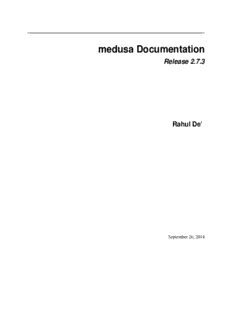
medusa Documentation PDF
Preview medusa Documentation
medusa Documentation Release 0.2.0 Gregory Medlock Jul 28, 2020 Getting Started 1 Index 3 2 Indicesandtables 75 PythonModuleIndex 77 Index 79 i ii medusaDocumentation,Release0.2.0 Medusa is a tool for constraint-based reconstruction and analysis (COBRA) of ensembles. It builds on the cobrapy package(https://github.com/opencobra/cobrapy)byextendingmostsingle-modelfunctionalitytoefficientensemble- scaleanalysis. Additionally,Medusaprovidesnovelfunctionsfortheanalysisofensembles. ForinstallationinstructionsandhowtociteMedusa,pleaseseeREADME.rst. GettingStarted 1 medusaDocumentation,Release0.2.0 2 GettingStarted 1 CHAPTER Index GettingStarted • Why? • Installation 1.1 Why? 1.1.1 Where do ensembles come from? Intheconstraint-basedreconstructionandanalysis(COBRA)field,thereareavarietyofanalysesandapproachesthat havealternativeoptimalsolutions.Examplesofthiscomeupoftenwhenanalysesinvolveintegerprogramming,where variablesinaproblemareswitchedon/offtomaximizeorminimizeanobjectivevalue. Whenintegerprogrammingis appliedtofillingapsinagenome-scalemetabolicmodel(GEM)tofulfillafunction,suchasproductionofbiomass, therearegenerallymultiplesetsofequallylikelysolutionstotheproblem(e.g. thereismorethanoneuniquesetof reactionsofthesamesizethatenablegrowth). Beyondexamplesofanalyseswheremultiplesolutionswiththeexactsameobjectivevaluemightexist,keepingtrack ofmultiplesub-optimalsolutionsmightbevaluablebecauseabiologically-correctsolutionisalmostnevertheexact same as the most likely numerical solution. Instead, we can hedge our bets by maintaining an ensemble of feasible solutionstoaproblemthatallmeetsomeminimumacceptablelikelihood. The primary aim of medusa is to make ensemble analyses more accessible to the COBRA field so that we can start accounting for this uncertainty to improve our predictions and improve our reconstructions more efficiently. The softwareiswrittenanddevelopedwithusabilityasthetoppriority,secondarytoperformanceandnovelty. Thus,user feedback is essential–please do not hesitate to provide your thoughts or ask questions via an issue on the medusa githubrepository. 3 medusaDocumentation,Release0.2.0 1.2 Installation Stable releases of medusa are available through PyPI for Python 3 (Python 2 is not supported). To download and installthemostrecentstablerelease,installpipandrunthefollowingatthecommandline: $pip install medusa-cobra Youcanalsodownloadandinstallthedevelopmentversionofmedusaviagithub. Todothis,clonetheremotegithub repositorywith: $ git clone https://github.com/gregmedlock/Medusa.git Whenworkingfromaclonedrepository,youwillneedtomanuallyinstallthedependenciesformedusa. Firstinstall toolsnecessaryforsettinguptheenvironment: $ pip install --upgrade pip setuptools wheel Nownavigatetothedirectorygeneratedbycloning(e.g. defaultwillcreateafoldernamed“Medusa”inthelocation youperformedgit clone),theninstallthepackagerequirements: $ pip install -r requirements.txt thencheckoutthedevelopmentbranch: $ git checkout development thecheckoutcommandwillmakeyourlocalrepositoryreflecttheexactstateoftheremoterepository’sdevelopment branch. Aftercheckingoutthedevelopmentbranch,thelaststepistosetupmedusafordevelopment: $ python setup.py develop During usage, issues may arise with optional cobrapy dependencies that are not installed by default with medusa. Forthesekindsofissues,pleaseattemptafullinstallationofcobrapyandconsultthecobrapyinstallationinstructions. Examples • Parallelizedsimulations • Applyingmachinelearningtoguideensemblecuration • Statisticaltestingforensemblesimulations • AssessingensembleperformanceviaROC 1.3 Parallelized simulations In medusa, ensemble Flux Balance Analysis (FBA) can be sped up thanks to the multiprocessing Python module. Withthisapproach,eachcore(orprocessor)isassignedasubsetofensemblemembersforwhichtoperform FBA,speedingupthecomputationinproportiontothenumberofadditionalprocessorsallocated. Let’sloadatestmodeltodemonstrateparallelensembleFBA.Thisensemblehas1000members, soeachFBAstep willreturnfluxesforeachreactioninoneofthe1000members. In [1]: from medusa.flux_analysis import flux_balance from medusa.test import create_test_ensemble ensemble = create_test_ensemble("Staphylococcus aureus") Next, perform the actual simulations. To parallelize, just indicate the number of cores you’d like to use with the num_processes argument. medusa will not automatically recognize that you have additional cores available. We’llusethetimemoduletokeeptrackofhowlongthesimulationtakesgiventhenumberofcoresallocated. 4 Chapter1. Index medusaDocumentation,Release0.2.0 In [2]: import time runtimes = {} for num_processes in range(1,5): t0 = time.time() flux_balance.optimize_ensemble(ensemble, num_processes = num_processes) t1 = time.time() runtimes[num_processes] = t1-t0 print(str(num_processes) + ' processors: ' + str(t1-t0) + 's') 1 processors: 89.6445517539978s 2 processors: 45.74347114562988s 3 processors: 33.75276780128479s 4 processors: 27.72901201248169s In [5]: import matplotlib.pylab as plt fig,ax = plt.subplots() plt.bar(runtimes.keys(), runtimes.values(), align = 'center', alpha = 0.6) plt.xlabel('Number of processors') plt.ylabel('Runtime (s)') ax.set_xlabel('Number of processors',size=16) ax.set_ylabel('Ensemble Flux Balance \nAnalysis runtime (s)',size=16) ax.tick_params(axis='both', which='major', labelsize=12) ax.tick_params(axis='both', which='minor', labelsize=12) plt.savefig('parallel_fba.svg') Asyoucanseefromtheprintedoutputandtheplots,acoupleofadditionalcoresreallyspeedsthingsup. However, eachcorerequiresanadditionalcopyoftheensembleforitsindependentsimulations. Thisprocess(serializationand deserialization)leadstodiminishingreturnsasthenumberofcoresisincreased. Weareworkingonimprovingthis, butfornow,itisbesttochooseamodestnumberofcores(e.g. 2-4). 1.3. Parallelizedsimulations 5 medusaDocumentation,Release0.2.0 1.4 Applying machine learning to guide ensemble curation Anensembleofmodelscanbethoughofasasetoffeasiblehypothesesabouthowasystembehaves. Fromamachine learningperspective,thesehypothesescanalternativelybeviewedassamples(orobservations),eachofwhichhasa distinctsetoffeatures(i.e. themodelcomponentsthatvaryacrossanensemble)andcanfurthergeneratenewfeatures byperformingsimulations. AnexampleoftheanalysesenabledbythisviewofensemblescanbefoundinMedlock& Papin,whereensemblestructureandensemblesimulationsareusedtoidentifyreactionsthatarehigh-prioritytargets forcuration. In this example, we demonstrate how ensembles of genome-scale metabolic models and machine learning can be combinedtoidentifyreactionsthatmightstronglyinfluenceasingleprediction(fluxthroughbiomass). Wewilluse anensembleforStaphylococcusaureusthatcontains1000members. Theensemblewasgeneratedthroughiterative gapfillingtoenablegrowthonsingleC/NmediaconditionsusingadraftreconstructionfromModelSEED. In [1]: import medusa from medusa.test import create_test_ensemble ensemble = create_test_ensemble("Staphylococcus aureus") Usingtheensemble, we’llperformfluxbalanceanalysisandreturnfluxthroughthebiomassreaction(whichhasan IDof"bio1"). Theensemblealreadyhasthemediaconditionssetas“complete”,meaningtheboundaryreactions foralltransportablemetabolitesareopen(e.g. thelowerboundofallexchangereactionsis-1000). In [2]: from medusa.flux_analysis import flux_balance biomass_fluxes = flux_balance.optimize_ensemble(ensemble, return_flux="bio1", num_processes = 4) Theoptimize_ensemblefunctionreturnsapandasDataFrame,whereeachcolumnisareactionandeachrowis anensemblemember. Forillustration,herearethevaluesforthefirst10membersoftheensemble: In [3]: biomass_fluxes.head(10) Out[3]: bio1 Staphylococcus aureus_gapfilled_518 118.238182 Staphylococcus aureus_gapfilled_860 122.523063 Staphylococcus aureus_gapfilled_900 104.905551 Staphylococcus aureus_gapfilled_434 148.353976 Staphylococcus aureus_gapfilled_343 134.100850 Staphylococcus aureus_gapfilled_706 116.982207 Staphylococcus aureus_gapfilled_175 137.352545 Staphylococcus aureus_gapfilled_85 110.488964 Staphylococcus aureus_gapfilled_345 119.439103 Staphylococcus aureus_gapfilled_161 118.237318 Togetasenseforthedistributionofbiomassfluxpredictions,wecanvisualizethemwithmatplotlib: In [4]: import matplotlib.pylab as plt fig, ax = plt.subplots() plt.hist(biomass_fluxes['bio1'], bins = 15, color = 'black', alpha = 0.4) ax.set_ylabel('# ensemble members') ax.set_xlabel('Flux through biomass reaction') plt.savefig('pre_FBA_curation.svg') plt.show() 6 Chapter1. Index
Description: